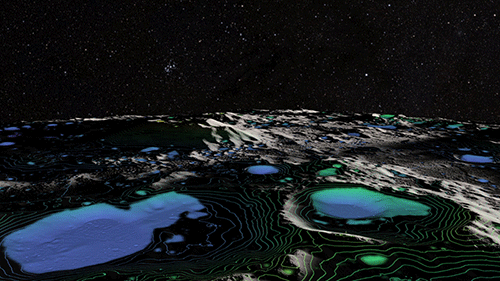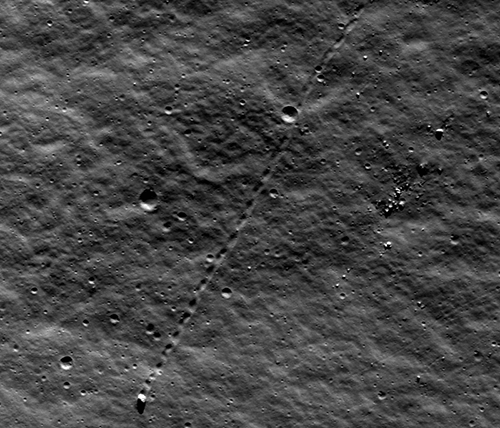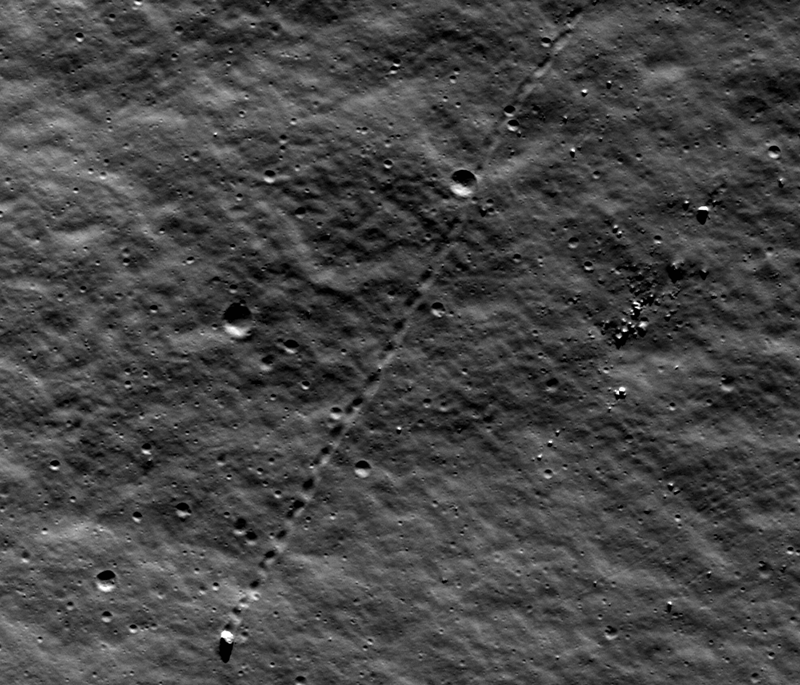Seeing into the Moon’s Dark Patches
The Moon’s surface is littered with lacerations. Created by boulders that were sent rolling by an asteroid or seismic event, these grooves helped scientists during the Apollo era to determine whether the lunar soil and gravel could support a massive lander or rover. But in the 47 years since humans last walked on the Moon, this technique of “boulder tracking” has lain dormant. Now a team of planetary scientists is reviving it, but this time, their search focuses on the boulders that plummet into craters that have never been warmed by the Sun’s rays. The findings could influence missions to these largely unexplored areas, said Hannah Sargeant, a graduate student at The Open University in the UK, who presented the team’s work at the recent Lunar and Planetary Science Conference in Houston (see pdf).
The gloomy depths of the Moon’s permanently shadowed regions (PSRs)—the insides of craters that never point toward the Sun—rarely heat to above a few tens of degrees Kelvin. Such dark and inhospitable environments may be unobvious candidates for future missions to the Moon. But their bone-chilling landscapes make them perfect habitats for trapping and storing life-giving water, and satellite data confirmed last year that water ice exists in PSRs.
“Water is one of the key resources that we’ll need if we want to inhabit the Moon, not just in terms of life support, but also because hydrogen and oxygen can be used to make rocket fuel,” Sargeant said. But to access this water, scientists need to be sure that the soil and gravel in the shadowy regions can handle the tread of a 4-ton rover. “We don’t want to send a rover there and then find it sinks and disappears,” Sargeant said. “That is an expensive way to learn a lesson.”
There’s reason to worry about whether a rover can safely land and roam the Moon. Many meters of soil and gravel cover the lunar surface. If this outer layer is weak, it could give way under a heavy rover, sucking the vehicle into a dusty abyss. Scientists can determine the likelihood of this happening by using the width and depth of boulder tracks to calculate the soil’s ability to bear a load.
Unfortunately, the unlit PSRs are near impossible to image from Earth by conventional means. To circumvent this problem, Sargeant, along with nine other graduate students and planetary scientist David Kring of the Lunar and Planetary Institute (LPI) in Texas, focused on craters that receive “secondary” sunlight, diffuse light that reflects off the dark craters’ walls into their shadowy depths. This scattered light illuminates the crater just enough to provide contrast between its bumps and crevices. Sophisticated image manipulation techniques can then further enhance this contrast, revealing otherwise hidden features.
The international team spent ten weeks over the summer of 2018 at the LPI, searching the Moon’s southern, permanently shadowed craters for boulder-made grooves. “I started seeing boulder tracks in my sleep,” Sargeant said.
With the markings in hand, they determined the depths and widths of each track and the dimensions of the boulders. They then calculated the soil’s “bearing capacity,” a parameter that indicates the load a substance can support without giving way. For the 13 tracks they found, their results showed that PSRs have bearing capacities that range from those of loosely packed sand to those of densely packed gravel.
The team’s calculated bearing capacities for the PSRs are comparable to, and in some cases larger than, those that they determined for sunlit regions of the Moon. The values indicate that the ground should support the weight of future rovers, said team member Valentin Bickel, who has a joint appointment at the Swiss Federal Institute of Technology (ETH) and the Max Planck Institute for Solar System Research, Germany. As examples, he pointed to NASA’s truck-sized Lunar Electric Rover and the jumping robot Space Bok, which was developed at ETH and is being tested by the European Space Agency (ESA).
Bickel and Sargeant both hope that a visit to PSRs could happen in the near future. The Chinese Space Agency, ESA, and NASA all confirmed at the conference that they plan to have rovers on the Moon as soon as 2023. And NASA announced plans on March 26th to send humans to the Moon’s southern pole by 2024. If those missions head toward dark craters, Sargeant said, “the rovers shouldn’t sink to the point of no return.”
–Katherine Wright
Katherine Wright is a Senior Editor for Physics.
Correction (2 April 2019): The sub headline of the story misstated that the research was carried out at NASA. The work was carried out at the Lunar and Planetary Institute in Texas, with the team visiting NASA’s Johnson Space Center at regular intervals over the course of the project.







